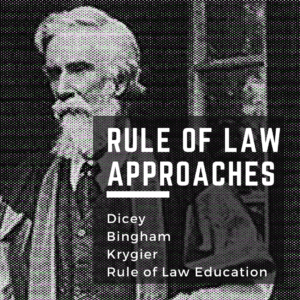Principles of the Rule of Law
The rule of law is best described as:
‘the people (including, one should add, the government) should be ruled by the law and obey it and that the law should be such that people will be able (and, one should add, willing) to be guided by it.’
– Geoffrey de Q. Walker, The rule of law: foundation of constitutional democracy, (1st Ed., 1988).
The relevance of the rule of law is demonstrated by application of the following principles in practice:
- The law is applied equally and fairly, so that no one is above the law.
- The separation of powers between the legislature, the executive and the judiciary.
- The judicial system is independent and impartial with open justice
- The law is made by representatives of the people in an open and transparent way.
- The law is capable of being known by everyone, so that everyone can comply.
- People can only be punished in accordance with the law
- No one is subject adversely to a retrospective change of the law or prosecuted, for any offence not known to the law when committed.
- Government agencies to act as model litigants
- A fair and prompt trial.
- All people are presumed to be innocent until proven otherwise and are entitled to remain silent and are not required to incriminate themselves.
- The law and its administration is subject to open and free criticism by the people, who may assemble without fear.
‘The rule of law is an overarching principle which ensures that Australians are governed by laws which their elected representatives make and which reflect the rule of law. It requires that the laws are administered justly and fairly.’
– Robin Speed, Founder, Rule of Law Education Centre
There have been other approaches and definitions of the rule of law such as Dicey’s three principles of the rule of law and Lord Bingham’s eight principles. These can be seen on our page on Rule of Law Approaches.
The Rule of Law Wheel
To inspire discussion of the Rule of Law in practice, we use our Rule of Law Wheel which provides a way to imagine the principles and legal traditions that contribute to maintaining the rule of law in Australia.
Click on each section of the wheel below to learn more about the different principles of the rule of law:
Read more about the Rule of Law Wheel on our What is the Rule of Law page or by downloading the Rule of Law Wheel Poster.

